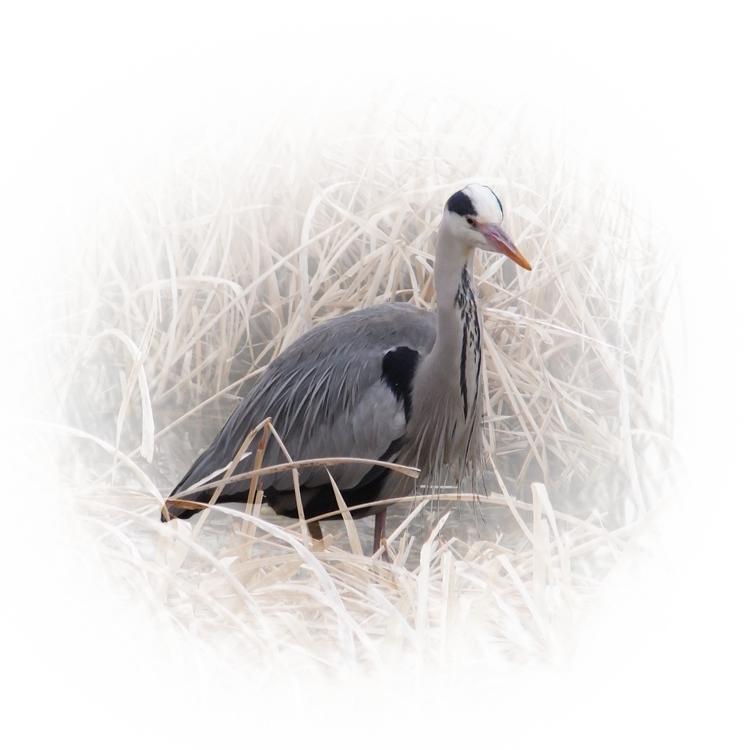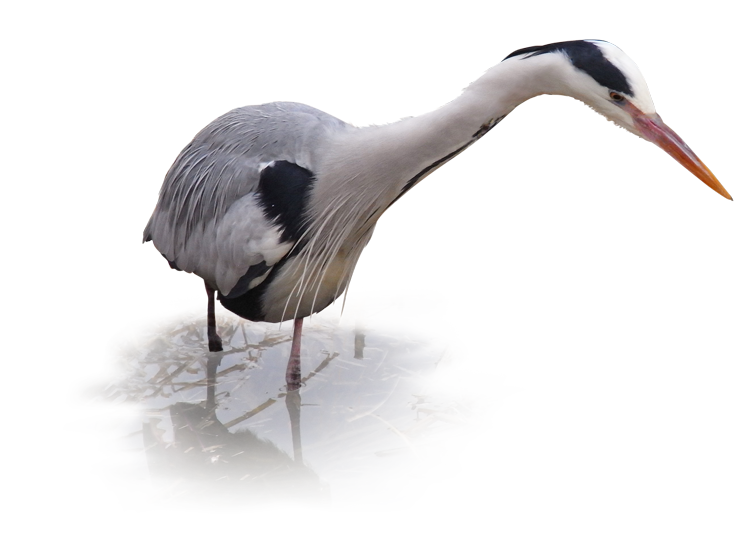
Ardea cinerea (Linnaeus, 1758)
死と誕生の象徴
Symbol of Death and Birth
体高は100cm、翼開長は155 – 195cmになる日本国内で見られるサギとしては最大種です。ヨーロッパからユーラシア大陸、日本にかけて北半球に広く分布しています。河川や湖沼、水田などの湿地帯に生息しており、魚を主食としながら動くものは何でも食べます。直立姿勢で待ち伏せて近くを通り過ぎる獲物を鋭い嘴で素早く一突きして捕らえます。
古くから人里に近くに生息して人との関わりが深いアオサギですが、西洋と遠く離れた日本では文化的な違いがあります。
古代エジプトではナイル川の氾濫がゆっくりと引いた時、最初に姿を現す鳥の一つでした。また朝日と共に湿地に降り立つ容姿などから、太陽・創造・再生の象徴「ベンヌ」として石版などに描かれ、ギリシャ神話にはフェニックス(不死鳥)伝説の原型になりました。
一方日本では古来より妖怪に近い不気味な存在と見られていたようです。清少納言は『枕草子』の中で、アオサギを「見た目が醜い。目つきも気味悪くかわいいものではない。」と記しています。また夏目漱石は『夢十夜』の中で闇の使いのように描いています。現代の作品では宮崎駿の映画『君たちはどう生きるか』があります。アオサギは主人公を導く不気味な存在として登場します。
古代エジプトの「ベンヌ」はあの世とこの世を行き来する存在でした。『君たちはどう生きるか』でもアオサギはそのような役割を果たします。昼行性でありながら、闇夜も飛翔することのあるアオサギは死と誕生の使者であるイメージにふさわしいようです。
都会の公園でも時折見かけるアオサギは、警戒心が強く監視するような目つきで人の行動を覗き見ているように感じられます。アオサギに声を掛けられた時、幸運または不吉が差し迫っているのかもしれません。
It is the largest species of heron found in Japan, with a height of 100cm and a wingspan of 155-195cm. It is widely distributed in the Northern Hemisphere, from Europe to Eurasia and Japan. It lives in wetlands such as rivers, lakes, and rice fields, and eats anything that moves, while mainly eating fish. It waits in ambush while standing upright and catches passing prey with a quick stab of its sharp beak.
The heron has been closely related to humans since ancient times, living close to human settlements, but there are cultural differences between the West and faraway Japan. In ancient Egypt, it was one of the first birds to appear when the floodwaters of the Nile slowly subsided. In addition, because of its appearance of descending on the wetlands with the morning sun, it was depicted on stone tablets, a symbol of the sun, creation, and rebirth, and in Greek mythology it became the prototype of the Phoenix legend.
On the other hand, in Japan, it seems to have been seen as an eerie presence similar to a monster since ancient times. Sei Shonagon wrote in “The Pillow Book” that the grey heron “It looks ugly. Its eyes are creepy and not cute.” Natsume Soseki also portrayed it as a messenger of darkness in “Ten Nights of Dreams”. In modern works, there is Hayao Miyazaki’s film “The Boy and the Heron” in which the grey heron appears as an eerie presence that guides the protagonist.
In ancient Egypt, the “Bennu” was a being that traveled between this world and the other. The grey heron plays a similar role in “The Boy and the Heron”. Although it is diurnal, the grey heron also flies in the dark, so it seems appropriate for the image of a messenger of death and birth.
The grey heron, which can sometimes be seen in city parks, seems to be spying on people’s actions with a watchful and watchful gaze. When a grey heron calls out to you, it may mean that good luck or bad luck is imminent.

練馬区立石神井公園に生息するアオサギ
Grey herons inhabiting Shakujii Park, Nerima City
参考文献
piro piro piccolo 『意外と知らない鳥の生活』KADOKAWA, pp104-109. 2025年5月18日閲覧
産経新聞 | 日本語メモ | 吉兆か怪異か、神秘的な「アオサギ」| (2023年9月3日) 2025年5月18日閲覧
アオサギを議論するページ | 文学の中のサギ | (2011年1月29日) 2025年5月18日閲覧
朝日新聞 | 記事 | 夏目漱石「夢十夜」第三夜 | (2016年3月11日) 2025年5月18日閲覧
“Tablet with the Representation of a Heron” Musum of Fine Arts, Budapest. 2025年5月18日閲覧
WEB野鳥図鑑 | 【アオサギの生態図鑑】どう生きている?エジプト文明とジブリ映画と大食漢アオサギの関係 | (2023年8月29日) 2025年5月18日閲覧